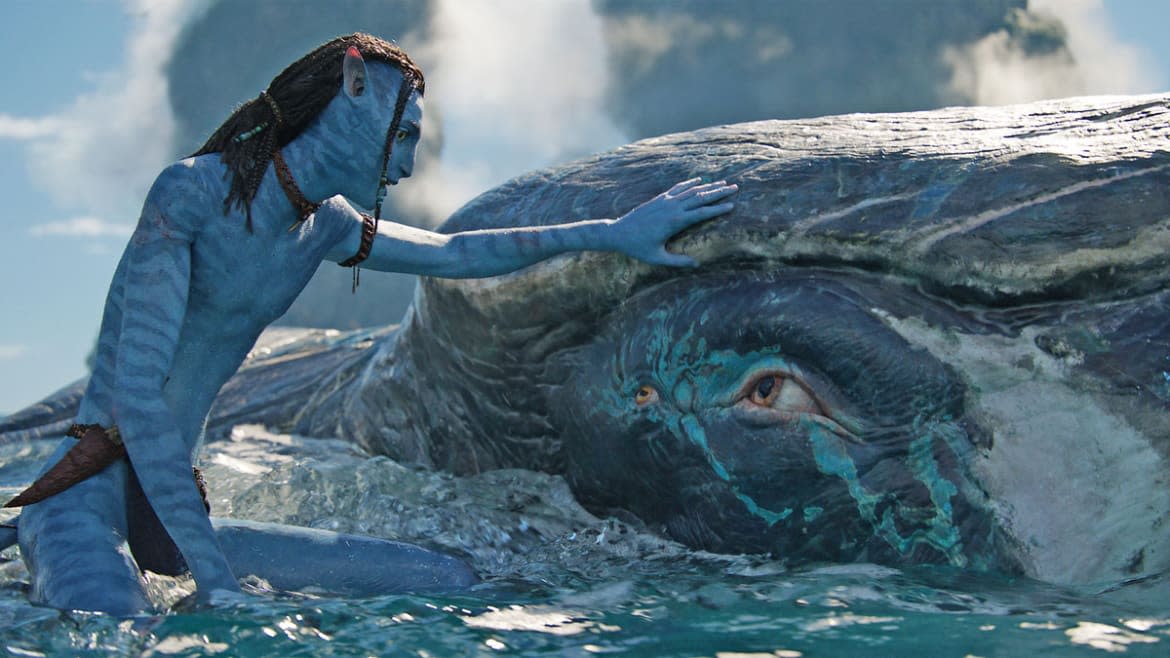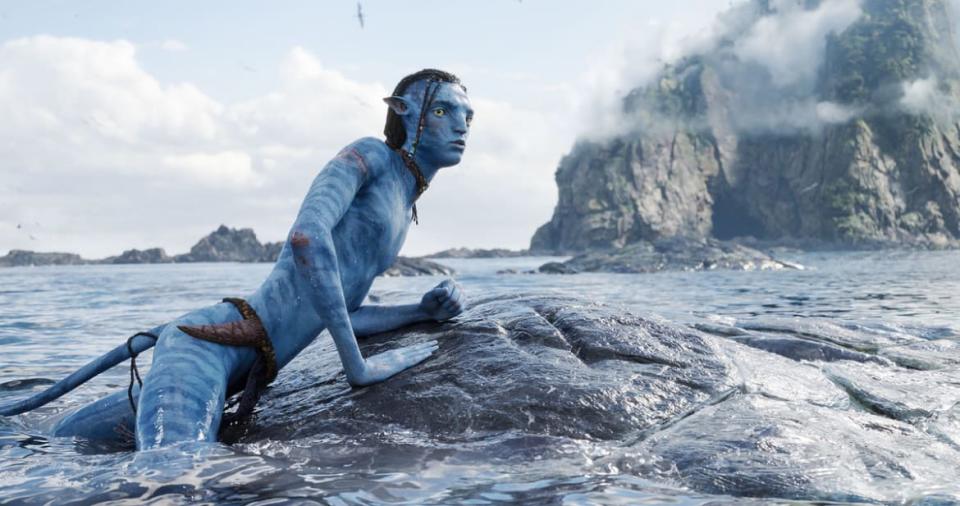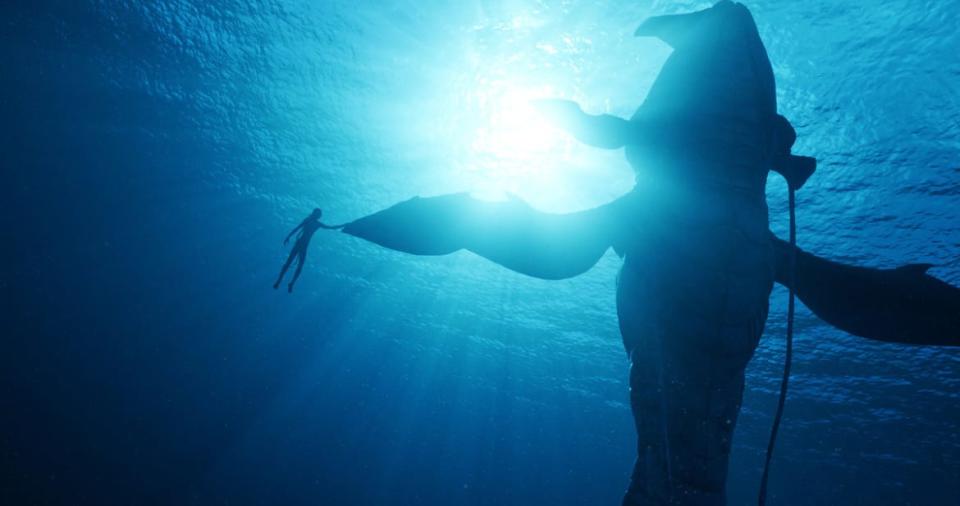‘Avatar: The Way of Water’ Is Really the Story of a Boy and His Whale

- Oops!Something went wrong.Please try again later.
I watch an outrageous number of films (to the point where people around me likely worry), so let me tell you it’s no hyperbole to say that Avatar: The Way of Water features the most beautiful scenes I’ve ever seen in a movie. Based on its title, you won’t be shocked to learn that water features prominently in the sequel. The plot involves Jake Sully (Sam Worthington) and his family traveling to a new realm of Pandora, finding the reef people, who make amazing use of the water around them. There’s a lot of opportunity to explore the majestic world that lies beneath the water, and the film is never more breathtaking than when the Na’vi are underwater.
But the real reason director James Cameron’s sequel to 2009’s Avatar is a smashing success is that it grounds the visual spectacle in a surprising emotional core. The film uses a familiar, tried-and-true storytelling formula of the indescribable bond between a boy and his dog—or, as James Cameron would have it, a boy and his whale. Free Willy stans, your time is up. Avatar: The Way of Water is now the definitive boy-and-his-whale movie.
Why ‘Avatar: The Way of Water’ Isn’t Worth the 13-Year Wait
Spoilers for Avatar: The Way of Water ahead.
Of course, this is Avatar we’re talking about, so you know darn well that I’m not talking about some regular whale. Everything in these movies is bigger, wilder, and more beautiful than mere mortals can imagine. There are no ordinary whales (is there anything ordinary about those incredible beings of the deep blue sea?) in The Way of Water; these mighty sea beasts are known as tulkun. They look like whales, but have more eyes, bigger jaws, bigger fins, bigger … well, you get the idea. They are MASSIVE. They can also communicate with the Na’vi, which fulfills the fantasy every animal lover has ever had—leaving me not only in awe of these tulkun, but also deeply jealous of the Na’vi.
Our first run-in with the tulkun comes when some teen bullies take Jake’s son Lo’ak (Britain Dalton) out beyond the safety of the reef, abandoning him at the last minute to teach him a lesson sure to end in his demise. (Sure, these kids have some corny, dated dialogue, but credit where it’s due: Sending a kid to his death is quite the bully move.) As the bullies were hoping, Lo’ak is attacked by a frightening sea creature, but before it can take him down, it’s brutalized by a magnificent tulkun. Immediately, we get a sense of their incredible size and power, which allows us to be swept away by their magnificence from the jump.
Lo’ak forms an instant bond with the tulkun. He helps remove what looks like an anchor from the creature’s fin, and the tulkun is immediately grateful. They communicate with each other; I can’t stress it enough—the tulkun can talk! The tulkun, who Lo’ak later discovers is named Payakan, has its dialogue translated into a gaudy papyrus-like font on screen, which fits perfectly in this world.

When Lo’ak returns home and speaks to the reef Na’vi, he discovers something startling—Payakan is known as a vicious dangerous killer. This is a crucial moment, as Lo’ak immediately jumps to the tulkun’s defense. Lo’ak is an outcast himself, which the two bond over in one beautiful scene, and he doesn’t hesitate to come to Payakan’s defense. This is exactly how people feel about their beloved pets: Nobody understands our beautiful animals as we do, and while Payakan doesn’t belong to Lo’ak, the film knows this dynamic well.
What unfolds is an inspiring relationship between Lo’ak and Payakan. We understand that Lo’ak feels different from everyone else around him; he doesn’t relate to his older brother, nor his father, and feels like he can’t possibly reach the level of stature Jake has accumulated in his time in Pandora. But when Lo’ak is with Payakan, everything seems to make sense.
The resulting relationship between Lo’ak and Payakan may just be the best person/animal friendship in cinema. Cameron gives Payakan an epic backstory and personality with a depth that rivals the complexity of a human character. This is so rare for an obvious reason—animals don’t talk on planet Earth—but this is Pandora. Cameron is going to do whatever he damn well pleases, and I’m going to eat it up.
Why Are the Teens in ‘Avatar: The Way of Water’ the Absolute Worst?
Not only do we learn a lot about Lo’ak and Payakan through their friendship, but the film teaches us about the tulkun as a species. In one of the sweetest, most surprising moments of the film, all the tulkun migrate back to join the reef Na’vi, and we learn the extent of the bond between these species. They communicate with one another, sing to each other, and enjoy general merriment as they catch up on each other's lives. It could feel a bit silly, but there’s so much heart and honesty behind everything going on that it’s awfully hard to not get swept up in the beauty of it all.
We don’t have to imagine what Payakan has gone through, because he tells Lo’ak everything he needs to know (they can communicate, remember!). Lo’ak does that weird hair-inserting thing to bond with Payakan, which allows him to see Payakan’s past. It’s even more tragic than you could imagine” Payakan’s mother was killed by hunters, who we later learn hunt tulkun for something in their bodies called Amrita, which has the highly sought-after ability to stop humans from aging. (This is similar to the plight of the whale on Earth, as ambergris, secreted by whales, was long considered highly desirable and used in perfume, though it has largely been replaced by synthetics).
Payakan, left devastated over the loss of his mother, led an attack against the humans that killed his mother. Tragically, the fight is a failure, and the tulkun that followed Payakun into the fray lost their lives. Payakun returned to the rest of his kind alone, and the other tulkun exiled him, blaming him for the death of their friends. My heart ached for Payakun; I was equally impressed by his bravery in opening up about his trauma and crushed by the cruelty he experienced.

It’s a risky move for Payakan to tell Lo’ak all of this, as he could react as the other tulkun did, and leave him alone yet again. But Lo’ak has formed a powerful spiritual and emotional bond with Payakan and understands that his mistakes do not define him. The moment could have torn them apart, but it ends up bringing them together even more.
The biggest test of their friendship is when Payakan finally gets the chance for revenge against the hunter that killed those he loved dearest. Payakan doesn’t just take down a hunter—he rips his freaking arm off! It’s an absolutely euphoric (if slightly disgusting) moment that feels totally earned. It’s the kind of moment that leaves audiences hooting and hollering at the screen, not just because it’s cool, but because it’s a deserved comeuppance for the film’s best character.
The relationship between man and our furry (or scale-y) best friends is well-worn in Hollywood. These films work because they understand that in our bonds with animals—even without words, we have an unspoken understanding of one another. Even if that may be slightly misjudged (they cannot speak to us), as someone who has loved many a cat and dog in my lifetime, I know the unshakable bond well.
As the world continues to heat and seemingly every species of animal is endangered, James Cameron has found the perfect time to celebrate the wonder of the world around us, diving deep underwater to bring us up close and personal in the magical world of Payakan and the tulkun. The Way of Water often feels like a call to arms, highlighting the plight of animals while showcasing their magnificence, as well as what happens when humanity. It’s rousing, and for sweet, glorious Payakan, you better believe I’m ready to fight.
Get the Daily Beast's biggest scoops and scandals delivered right to your inbox. Sign up now.
Stay informed and gain unlimited access to the Daily Beast's unmatched reporting. Subscribe now.

